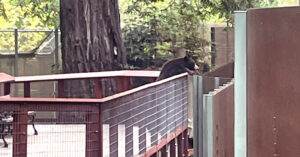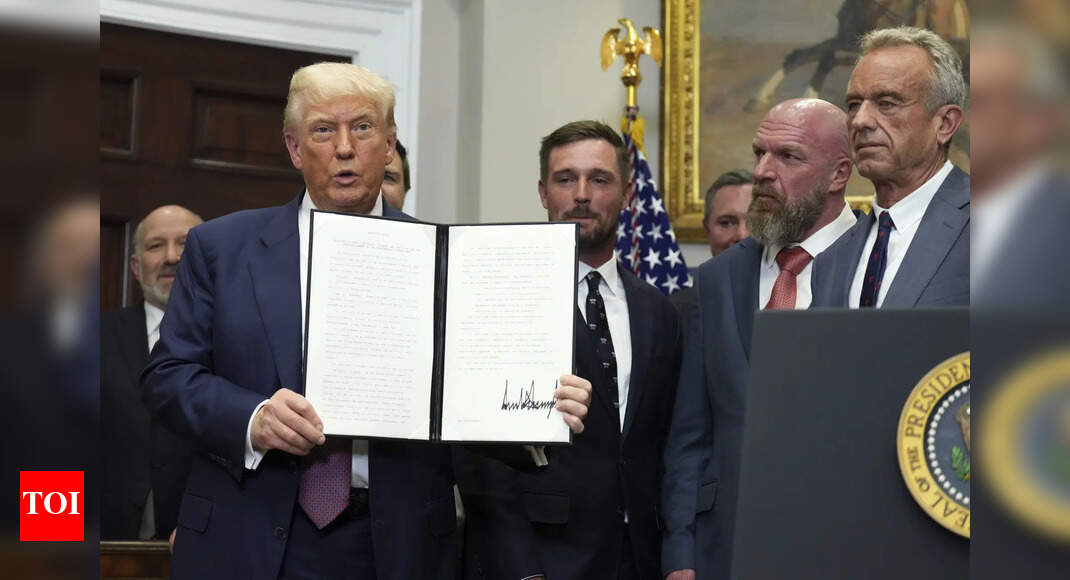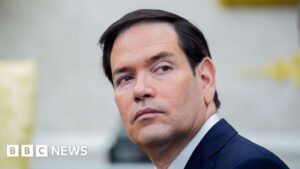US President Donald Trump has implemented a revised trade tariff regime under his “America First” policy, effective August 7. It imposes a default 10% tariff on 68 nations and the EU, with higher rates for countries with trade deficits, starting at 15%. Syria faces the highest tariff at 41%.
US President Donald Trump on Thursday signed a sweeping executive order imposing higher tariffs on several nations and the 27-member European Union, significantly escalating his administration’s global trade offensive. The order, titled “Further Modifying The Reciprocal Tariff Rates”, is set to take effect from August 7, seven days after its issuance, with rates going up to 41%. India has been slapped with a 25 per cent “Reciprocal Tariff, Adjusted”, one of the higher rates among key US trading partners. The White House justified the move by citing India’s “obnoxious non-monetary trade barriers,” persistent trade imbalances, and strong energy and defense ties with Russia.
‘Take Dead Economies Down Together, Don’t Care: Trump Stuns With Fresh Tariff Salvo At India, Russia
While the initial tariff deadline was August 1, the implementation was deferred to August 7 to allow US Customs and Border Protection time to update its systems. The extension reflects the govt’s need for more time to harmonise the tariff rates, according to a senior official who spoke to Associated Press reporters on condition of anonymity.
Global rebalancing: Some nations hit harder
The tariff hike is part of Trump’s effort to rebalance what he terms unfair trade deficits and national security risks. Countries with large trade surpluses with the US or insufficient strategic alignment have been hit with the steepest increases. The steepest hikes include 41 per cent on Syria, 40 per cent on Laos and Myanmar, 39 per cent on Switzerland, 35 per cent on Iraq, Serbia and Canada. In South Asia, India faces a 25 per cent tariff, while Pakistan has been hit with 19 per cent, according to the new Executive order. The US has announced adjusted reciprocal tariffs on 95 countries and territories, ranging from 10 per cent to 41 per cent, based on trade deficits and strategic alignment. Also read: ‘Major success’ or ‘factless turbulence’? Here’s how nations reacted to Trump’s new tariffs
Tariff Rates by Country: Full list under Trump’s executive order
The US has announced adjusted reciprocal tariffs on several countries and territories, ranging from 10 per cent to 41 per cent, based on trade deficits and strategic alignment. Here’s what country faces what rate:
Country/TerritoryAdjusted Reciprocal TariffAfghanistan15 per centAlgeria30 per centAngola15 per centBangladesh20 per centBolivia15 per centBosnia and Herzegovina30 per centBotswana15 per centBrazil10 per centBrunei25 per centCambodia19 per centCameroon15 per centChad15 per centCosta Rica15 per centCôte d’Ivoire15 per centDemocratic Republic of the Congo15 per centEcuador15 per centEquatorial Guinea15 per centEuropean Union (Goods >15%)0 per centEuropean Union (Goods <15%)15% minus Column 1 dutyFalkland Islands10 per centFiji15 per centGhana15 per centGuyana15 per centIceland15 per centIndia25 per centIndonesia19 per centIraq35 per centIsrael15 per centJapan15 per centJordan15 per centKazakhstan25 per centLaos40 per centLesotho15 per centLibya30 per centLiechtenstein15 per centMadagascar15 per centMalawi15 per centMalaysia19 per centMauritius15 per centMoldova25 per centMozambique15 per centMyanmar (Burma)40 per centNamibia15 per centNauru15 per centNew Zealand15 per centNicaragua18 per centNigeria15 per centNorth Macedonia15 per centNorway15 per centPakistan19 per centPapua New Guinea15 per centPhilippines19 per centSerbia35 per centSouth Africa30 per centSouth Korea15 per centSri Lanka20 per centSwitzerland39 per centSyria41 per centTaiwan20 per centThailand19 per centTrinidad and Tobago15 per centTunisia25 per centTurkey15 per centUganda15 per centUnited Kingdom10 per centVanuatu15 per centVenezuela15 per centVietnam20 per centZambia15 per centZimbabwe15 per cent
'National interests first': Where does India stand amid this tariff flurry
The US has openly linked its new tariff measures on India to frustrations over New Delhi’s continued purchases of Russian oil and arms. US Secretary of State Marco Rubio said India’s energy trade with Russia is “most certainly a point of irritation” in ties, as it helps sustain Moscow’s war effort in Ukraine. While acknowledging India as a strategic partner with major energy needs, Rubio added that Washington is “clearly frustrated” that India continues to buy large volumes of discounted Russian oil despite the availability of other global vendors. Also read: Donald Trump administration fires fresh salvo after 25% tariff; says Russia oil ‘most certainly a point of irritation’ Trump’s imposition of a 25 per cent tariff on Indian goods and an additional penalty for Russian dealings is seen as a sharp expression of that dissatisfaction. Trump also accused India of maintaining “obnoxious” non-monetary trade barriers and failing to open up its market to American goods. The government, meanwhile, has reiterated that it will act in its national interest. The Ministry of Commerce said it is assessing the impact of the new tariffs and penalties, while also emphasising that discussions with the US for a fair and reciprocal trade agreement are ongoing. Five rounds of negotiations have taken place, with a sixth round expected later this month. India has maintained a firm stance on key issues such as agriculture and dairy, where it has resisted US demands for greater market access. Also read: No F-35 jets from US for India? Govt mulls next steps after 25% tariff shock
End of Article
Follow Us On Social Media













